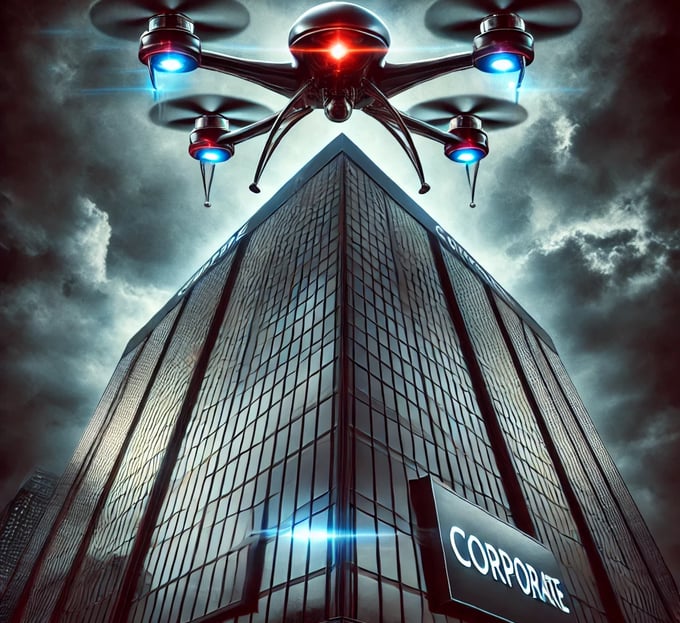The New Thing for Corporate America: Drone Harassment?
In today's fast-evolving corporate landscape, companies are finding new, disturbing ways to intimidate, control, and silence individuals. One of the most alarming trends? Drone harassment — a rising tactic used to monitor, harass, and psychologically torment individuals with very few legal protections in place. While drones are often associated with aerial photography, delivery services, and recreation, some corporations have found ways to exploit these devices to harass employees, whistleblowers, or anyone they consider a threat. With limited regulations governing drone surveillance, victims are often left defenseless against this modern form of intimidation.
HARASSMENTDRONESSTALKING
Joe Fulmer
3/20/2025


The New Thing for Corporate America: Drone Harassment?
Very Little Lawfare, Plenty of Loopholes — Exploiting Victims for Control
In today's fast-evolving corporate landscape, companies are finding new, disturbing ways to intimidate, control, and silence individuals. One of the most alarming trends? Drone harassment — a rising tactic used to monitor, harass, and psychologically torment individuals with very few legal protections in place.
While drones are often associated with aerial photography, delivery services, and recreation, some corporations have found ways to exploit these devices to harass employees, whistleblowers, or anyone they consider a threat. With limited regulations governing drone surveillance, victims are often left defenseless against this modern form of intimidation.
The Rise of Drone Harassment in Corporate America
Drones are powerful tools with the capability to: ✅ Track individuals over long distances ✅ Capture video or audio surveillance without consent ✅ Disrupt personal privacy by hovering near homes or workplaces ✅ Interfere with mobile communications, Wi-Fi, and personal security systems
For corporations facing lawsuits, whistleblowers, or even outspoken employees, drones have become an effective weapon. They allow companies to stalk individuals in ways that are difficult to trace and even harder to prove in court.
In some reported cases, victims have described drones hovering over their homes for hours, circling their vehicles as they travel, or intercepting phone signals to disrupt communication. This form of intimidation is deeply unsettling — yet rarely prosecuted due to loopholes in existing laws.
The Legal Loopholes Enabling Drone Harassment
Despite the rapid growth in drone use, federal and state laws remain woefully underdeveloped. The FAA (Federal Aviation Administration) has rules governing drone altitude, airspace violations, and safety — but none specifically address harassment or targeted surveillance.
While some states have passed privacy laws restricting drone use, many corporations exploit loopholes to avoid accountability. For example:
Drones flying over public property are generally legal, even if they track a specific individual.
Drones kept just above private property (outside FAA-defined airspace zones) can linger for hours without clear legal consequences.
Signal disruption or hacking via drones is difficult to trace, making it nearly impossible for victims to prove the source of tampered communications.
As a result, corporations willing to exploit these loopholes can weaponize drones without fear of legal repercussions.
The Psychological Toll on Victims
Victims of drone harassment report feeling:
Constantly watched — reducing their sense of safety at home or work
Anxious and paranoid — questioning who is behind the intimidation
Powerless — unable to find legal recourse or protection
Exhausted — due to the ongoing stress of unpredictable surveillance
For individuals already targeted by corporations through lawsuits, workers' comp disputes, or whistleblower retaliation, this added layer of harassment is designed to wear them down emotionally and mentally.
What Can Victims Do?
While the legal system has yet to catch up with drone harassment tactics, there are some steps victims can take:
Document Every Incident — Keep a record of drone sightings, including dates, times, and any photos or videos.
Report to Local Law Enforcement — While laws are limited, documenting harassment increases your chances of future legal recourse.
Contact the FAA — The FAA has guidelines that prohibit reckless or dangerous drone behavior. Filing a complaint may build a case against offenders.
Connect with Advocacy Groups — Groups like the Electronic Frontier Foundation (EFF) and the Electronic Privacy Information Center (EPIC) are actively pushing for stronger drone privacy laws.
Involve Your Community — Neighbors, friends, and local groups can help corroborate your experiences, especially if multiple residents are witnessing the same drone behavior.
The Fight for Stronger Laws
The lack of robust federal laws to address drone harassment gives corporations the upper hand. While some states have taken steps to restrict drone surveillance, these laws are inconsistent, and offenders can often cross state lines to evade accountability.
Advocates are calling for comprehensive reforms that:
Define drone harassment as a distinct legal violation
Empower victims to sue for emotional and psychological damages
Expand airspace protections for residential properties
Criminalize drone use in ways that disrupt communications or property security
Until these protections are strengthened, victims of drone harassment must rely on public exposure, community support, and alternative means to push back against this growing threat.
Conclusion: Exposing the Abuse of Power
Drone harassment is yet another tactic corporations have adopted to intimidate, demean, and manipulate those who stand in their way. By exploiting legal loopholes and deploying drones as a form of harassment, they create a hostile environment designed to break victims psychologically.
The more awareness is raised about this issue, the closer we come to closing these loopholes and protecting those who dare to speak out.
If you or someone you know has experienced drone harassment, it’s time to take action. Document the details, gather evidence, and don’t be afraid to share your story. Together, we can expose the truth and demand accountability.
JOEFULMER.COM
Copyright 2025. All rights reserved.
All content reflects my personal opinions, experiences, details, shared interactions, documents, and publicly available evidence. Disclaimer.
E: joe@joefulmer.com
C: 251.210.8636
Injured FedEx worker. Whistleblower. Surveillance target.
I’m exposing corporate abuse, drone harassment, and the truth they tried to bury.
🔗 gofundme.com/f/joefulmer
👁🗨️ @joefulmer on TikTok, YouTube, and X
💼 linkedin.com/in/joe-fulmer
🌐 joefulmer.com
